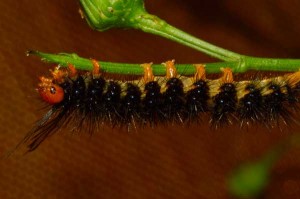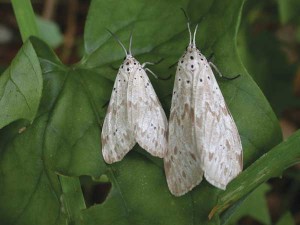
Secusio caterpillar eat fireweed and other invasive plants like Cape ivy, The Hawaii Department of Agriculture estimates it will take 8 caterpillars to kill one fireweed plant. Photo courtesy of HDOA.
A new fuzzy black caterpillar is starting to show up across Maui—a promising omen for cattlemen and conservationists alike. The caterpillar is the larva of the Secusio extensa moth, a biological control for firerweed released by the Hawai‘i Department of Agriculture (HDOA) to control fireweed in March of 2013.
Diana Crow, a horticulturalist with ‘Ulupalakua Ranch, has been helping to raise and release Secusio moths on Maui. “For a while I wasn’t seeing them at all. Then things changed when the rains came. I started seeing them around lights. That was the first indication they were reproducing in the wild.”
Impacts on fireweed aren’t likely to come immediately. Established in the islands since at least the 1980s, fireweed now infests an estimated 850,000 acres statewide. According to Rob Curtiss, an entomologist with HDOA, it takes an average of eight caterpillars to kill one fireweed plant. “What will probably happen is that the population [of Secusio] will continue to grow and reach epidemic proportions, then we will see them start to defoliate fireweed.”

Fireweed, Senecio madagascarensis, is a highly invasive weed, toxic to many animals that blankets pastures on Maui and Big Island. Photo courtesy of Forest and Kim Starr.
Secusio may be getting some help from another unwelcome pasture pest; the caterpillars are capable of living off Cape ivy, a noxious weed related to fireweed, and containing the same toxic properties. “It’s inedible for livestock,” says Crow of the ivy. “We don’t want it. Plus it’s a threat to higher elevation native forest.”
The moth’s broad appetite isn’t a surprise to state agriculture officials. Before Secusio was released, entomologists reared the caterpillars in captivity to test what plants they would eat. Confined in cages with 88 different kinds of plants (71 of which were related to fireweed), they found it only ate 6 different species, including Cape ivy, and all were closely related to fireweed. Any plant it caused significant damage on is considered a weed in Hawai‘i.
Also known as German ivy, Cape ivy is extremely invasive. Introduced at the turn of the century to Kona, Cape ivy escaped cultivation and now threatens watersheds and native forests on the Big Island and Maui. It spreads quickly and once established can be extremely tenacious. Pat Bily of The Nature Conservancy has found several small populations in the Waikamoi preserve. Using herbicide to control a smothering vine would damage native vegetation so Bily removes plants by hand. Every leaf, stem, and root have to be removed or the plant resprouts; eradicating a handful of small populations is taking Bily years.
“Any feeding on Cape ivy, even if it was low, is a benefit,” explains Rob Curtiss. “Cape ivy certainly can be an alternate host. If populations of fireweed go down and there are populations of Cape ivy in the area, they will sustain a larger population of Secusio and we’ll get a better impact on fireweed.”
How do you know if you have them? The larval stage of Secusio is a fuzzy black caterpillar

The Secusio moth is about the size of an almond with mottling on the wings. The moth is nocturnal; turning off lights in the evening will encourage the moth to return to fireweed plants to lay eggs. Photo courtesy of HDOA
with an orange head and sometimes orange feet. It ranges in size from 1/8th inch when young to just over 1 inch before pupating into a moth. The moth is beige with brown mottling on the wings and about the size of an almond.
Are other plants on the menu for the Secusio moth? Seeing the caterpillar on other plants doesn’t mean the caterpillar is feeding on them. According to Curtiss, most feeding happens at night. The caterpillars often leave the host plants during the day to avoid potential predation.
People may also see them when the caterpillars are looking for a place to pupate, preferring a dark place like a garage or shed. “If you see them, leave them alone or take them outside,” advises Curtiss. The moths are nocturnal and attracted to light so leaving outside lights on all night may keep them close to houses rather than seeking out fireweed in adjacent pastures.
For more information about the Secusio moth, visit the HDOA website: http://hdoa.hawaii.gov/blog/news-releases/2013-news-releases/biocontrol-moths-released-on-maui-to-fight-invasive-fireweed/
By Lissa Fox Strohecker. Originally published in the Maui News, July 13th, 2014 as part of the Kia‘i Moku Column from the Maui Invasive Species Committee.
